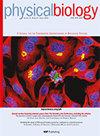最小的传感器阵列,用于定位使用电感测对象
IF 2
4区 生物学
Q4 BIOCHEMISTRY & MOLECULAR BIOLOGY
引用次数: 0
摘要
弱电鱼在自己产生的电场中对扰动进行编码,以感知它们的环境。使用这种电感定位物体需要从其皮肤上的场扰动的二维电图像中解码距离。许多通过弱电鱼和在一般情况下通过电传感进行目标定位的研究都集中在从电图像的不同特征中提取位置信息上。其中一些研究还考虑了在不同时间、从不同角度对电图像进行采样所获得的额外信息。在这里,我们采取了不同的视角,而是考虑在单个时间点(即恒定场)的空间中的单个点(即单个传感器或受体)处可用的信息。通过组合来自多个受体的信息,我们表明,物体的距离可以由传感表面上特定位置的四个受体以相对抗环境噪声的方式明确编码。这提供了使用电感解码物体的三维位置所需的信息(即受体阵列大小)的下限。本文章由计算机程序翻译,如有差异,请以英文原文为准。
Minimal sensor arrays for localizing objects using an electric sense
Weakly electric fish encode perturbations in a self-generated electric field to sense their environment. Localizing objects using this electric sense requires that distance be decoded from a two-dimensional electric image of the field perturbations on their skin. Many studies of object localization by weakly electric fish, and by electric sensing in a generic context, have focused on extracting location information from different features of the electric image. Some of these studies have also considered the additional information gained from sampling the electric image at different times, and from different viewpoints. Here, we take a different perspective and instead consider the information available at a single point in space (i.e. a single sensor or receptor) at a single point in time (i.e. constant field). By combining the information from multiple receptors, we show that an object’s distance can be unambiguously encoded by as few as four receptors at specific locations on a sensing surface in a manner that is relatively robust to environmental noise. This provides a lower bound on the information (i.e. receptor array size) required to decode the three-dimensional location of an object using an electric sense.
求助全文
通过发布文献求助,成功后即可免费获取论文全文。
去求助
来源期刊

Physical biology
生物-生物物理
CiteScore
4.20
自引率
0.00%
发文量
50
审稿时长
3 months
期刊介绍:
Physical Biology publishes articles in the broad interdisciplinary field bridging biology with the physical sciences and engineering. This journal focuses on research in which quantitative approaches – experimental, theoretical and modeling – lead to new insights into biological systems at all scales of space and time, and all levels of organizational complexity.
Physical Biology accepts contributions from a wide range of biological sub-fields, including topics such as:
molecular biophysics, including single molecule studies, protein-protein and protein-DNA interactions
subcellular structures, organelle dynamics, membranes, protein assemblies, chromosome structure
intracellular processes, e.g. cytoskeleton dynamics, cellular transport, cell division
systems biology, e.g. signaling, gene regulation and metabolic networks
cells and their microenvironment, e.g. cell mechanics and motility, chemotaxis, extracellular matrix, biofilms
cell-material interactions, e.g. biointerfaces, electrical stimulation and sensing, endocytosis
cell-cell interactions, cell aggregates, organoids, tissues and organs
developmental dynamics, including pattern formation and morphogenesis
physical and evolutionary aspects of disease, e.g. cancer progression, amyloid formation
neuronal systems, including information processing by networks, memory and learning
population dynamics, ecology, and evolution
collective action and emergence of collective phenomena.
 求助内容:
求助内容: 应助结果提醒方式:
应助结果提醒方式:


